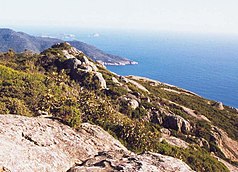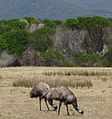Wilsons Promontory National Park
| Wilsons Promontory National Park | ||
|---|---|---|
| View from the top of Mount Oberon to South Point | ||
|
|
||
| Location: | Victoria , Australia | |
| Specialty: | Coastal landscape | |
| Next city: | Leongatha - Melbourne | |
| Surface: | 504.6 km² | |
| Founding: | 1898 | |
| Visitors: | 120,000 | |
| Waterloo Bay | ||
The Wilsons Promontory National Park (English Wilsons Promontory National Park ) is located on a peninsula on the southern tip of the Australian state of Victoria , about 160 km southeast of Melbourne . Most of the area is occupied by a promontory, the great region of the Wilsons Promontory, which lies in South Gippsland . In the Wilsons Promontory lies South Point at 39 ° 08 'S , the southernmost point of mainland Australia.
The southern tip of Victoria is made of granite that is subject to severe erosion .
history
Although there are hardly any rock carvings or the like, it is known that Aborigines from the Brataualong tribe lived in this area .
The first records of the region come from George Bass , who explored the coast of the foothills in 1798. Due to the massive granite deposits , settlement was initially not of interest. It wasn't until 1872 that a whaling station was established in Refuge Cove . In 1854 a sawmill was built in Sealers Cove.
In 1898 the Wilsons Promontory National Park The Prom was established and expanded to 490 km² to this day. The diverse landscape offers a habitat for around 700 plant species and a rich fauna.
fauna and Flora
The park's fauna and flora reflect much of that of Victoria State. Over 30 different native animals, not including marine mammals, are documented. In addition to various types of kangaroo , koalas , emus and wombats , these include lesser-known Australian animals such as rabbit kangaroos , broad -footed pouch mice ( Antechinus minimus ) and narrow-footed pouch mice ( Sminthopsis leucopus ). One of the largest populations of the New Holland mouse ( Pseudomys novaehollandiae ) is also located in the park and, although rarely, various whale species are spotted along the coast from time to time. One endangered species in the park is the demoiselle Hemiphlebia mirabilis , a living fossil. As in other areas of Australia, there are also introduced animals in the park, which pose a threat to native wildlife. These include foxes, cats, hares, starlings and blackbirds. The flora is very species-rich, especially favored by the various "microclimate zones" of the park. There are warm and cold rainforests, teatree forests, swamp and coastal plant populations, and heathland. The latter was strongly influenced by bush fires. The last bush fire in October 2006 destroyed 25 hectares of heathland. In the area around Millers Landing there are white mangrove forests, the southernmost on earth.
Visitor activities
Entry to the national park is free. Visitors have the option of camping in the park for a fee, staying overnight in designated camps or sleeping in their own caravan. Hiking in the park is one of the most popular activities.
Web links
- Official website
- Website about Wilsons Promontory (dt)
- Website & Map Wilsons Promontory (en)
- TI Wilson's Promontory
- TI Wilson's Promontory
Individual evidence
- ^ "Wilsons Promontory National Park - The Southern Tip of Australia", senior book in August 2013
- ↑ "Peak season bookings information", Parks Victoria 2013 ( Memento of the original from August 24, 2013 in the Internet Archive ) Info: The archive link was inserted automatically and has not yet been checked. Please check the original and archive link according to the instructions and then remove this notice.






